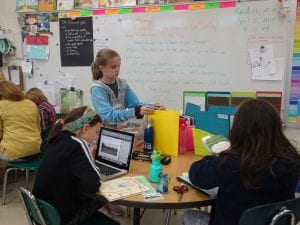 Thank you for the conversations you are having at home about behavior and effort. Thank you for the conversations about friendship and inclusion. Thank you for helping your children to find ways to make our classroom a happier place for learning and fun. It has made a difference. What a great way for our class to move into vacation.
Thank you for the conversations you are having at home about behavior and effort. Thank you for the conversations about friendship and inclusion. Thank you for helping your children to find ways to make our classroom a happier place for learning and fun. It has made a difference. What a great way for our class to move into vacation.
Wonder World
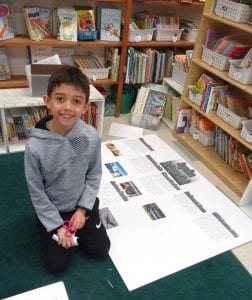 In addition to feeling better about how we are using our time in the classroom and being a friendlier classroom community, everyone put forth a great effort this week to meet research and paragraphing expectations of our project. It is important to step back and consider how many different skills and abilities come into play in this learning process. The children are reading complex information with little background knowledge. They don’t know much about history, religion, politics, economies or geography, and yet, using the idea of “Wonders” each student identified places, people and events they found beautiful, interesting and amazing from their country. Once they uncovered the Wonders, they dug deeper to understand each topic in more detail. They learned ways of determining the importance of the facts and to organize them into subtopics. In this project, their writing has become more organized and less list-like. They’ve paid attention to proper nouns – there were a lot of them – and tried to attend to sentence conventions as well.
In addition to feeling better about how we are using our time in the classroom and being a friendlier classroom community, everyone put forth a great effort this week to meet research and paragraphing expectations of our project. It is important to step back and consider how many different skills and abilities come into play in this learning process. The children are reading complex information with little background knowledge. They don’t know much about history, religion, politics, economies or geography, and yet, using the idea of “Wonders” each student identified places, people and events they found beautiful, interesting and amazing from their country. Once they uncovered the Wonders, they dug deeper to understand each topic in more detail. They learned ways of determining the importance of the facts and to organize them into subtopics. In this project, their writing has become more organized and less list-like. They’ve paid attention to proper nouns – there were a lot of them – and tried to attend to sentence conventions as well.
 As the displays are coming together, the children are feeling a real sense of accomplishment. They can see they have grown as researchers and writers since their Holiday Palooza presentation. They deserve to feel proud of themselves and their accomplishments.
As the displays are coming together, the children are feeling a real sense of accomplishment. They can see they have grown as researchers and writers since their Holiday Palooza presentation. They deserve to feel proud of themselves and their accomplishments.
We can’t wait to share all our learning, research and information writing in our global geography museum. Wonder World will be on Monday, April 29. We’ll be ready to share between 2:15 and 2:45 and again between 5:15 and 6:00. We hope to see you there.
Book Clubs – Endings and Beginnings
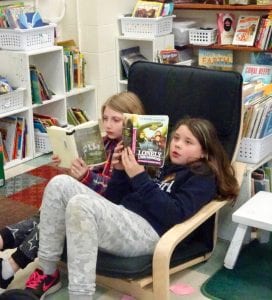 We completed one round of book clubs and intend to begin another when we come back from vacation. The children kept up with their responsibilities to be prepared to meet and discuss the main events of the chapters. They practiced using a several different responses and, at the end of the club meetings, were able to select the response type that helped them recall and question what was happening in the reading. Most exciting for me has been seeing children begin their own book clubs and use the response strategies independently.
We completed one round of book clubs and intend to begin another when we come back from vacation. The children kept up with their responsibilities to be prepared to meet and discuss the main events of the chapters. They practiced using a several different responses and, at the end of the club meetings, were able to select the response type that helped them recall and question what was happening in the reading. Most exciting for me has been seeing children begin their own book clubs and use the response strategies independently.
The children can see the benefit of reflecting on what they are reading and taking time to note the important details. Some of the children have tried to write everything, so we’ve been trying to decide what they author’s essential message is and talk about (rather than write) the details that we notice to support our ideas.
Bits and Pieces –
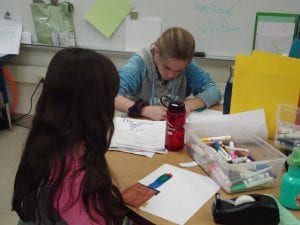 We have continued our work with fractions. We’re labeling parts of groups and parts of a whole when it is divided into pieces.
We have continued our work with fractions. We’re labeling parts of groups and parts of a whole when it is divided into pieces.- Green Ember is an exciting read-aloud. We are still putting all the pieces together and can’t wait to figure out what the battle is about and who the sides are in this fantasy adventure.
- We’ll be welcoming Ryan Harrington into our classroom when we return to school after vacation. He is moving here from South Hampton.
- We were able to transplant our Swiss chard seedlings into our square foot gardens and can’t wait to see how they will have changed when we return in a week’s time.
 A REMINDER – The Parade of States will be on Thursday, May 23th. The event will begin with a Recorder Concert in the cafeteria. The Parade of States will follow in the gymnasium. We’ll ask the children to arrive at 4:45 with the concert to begin promptly at 5:00 with the float parade to follow. The children will be selecting their states to research the week we return. They’ll identify their wonders – the items they’ll be placing on their floats – that week and into the next as well. Please be on the outlook for details about this project the week we return.
A REMINDER – The Parade of States will be on Thursday, May 23th. The event will begin with a Recorder Concert in the cafeteria. The Parade of States will follow in the gymnasium. We’ll ask the children to arrive at 4:45 with the concert to begin promptly at 5:00 with the float parade to follow. The children will be selecting their states to research the week we return. They’ll identify their wonders – the items they’ll be placing on their floats – that week and into the next as well. Please be on the outlook for details about this project the week we return.- It was a really busy week. I didn’t take the usual amount of photographs. Sorry that so few children’s photos are included in this week’s family letter.
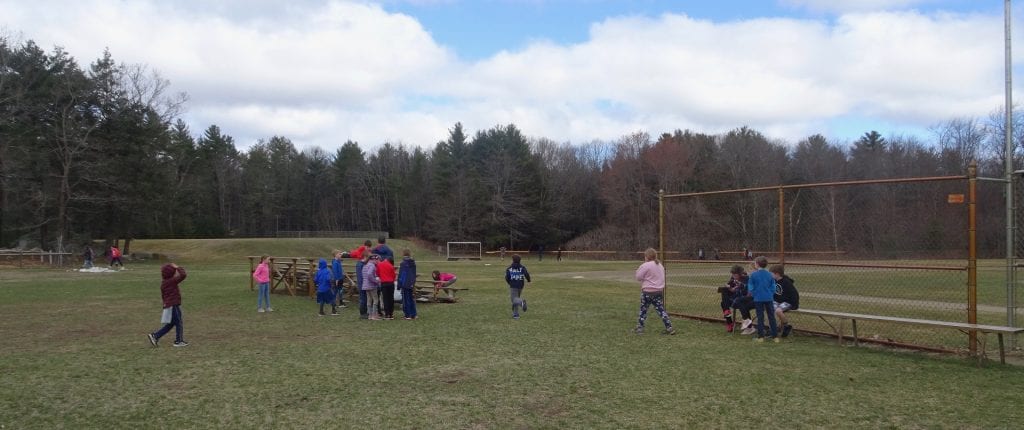
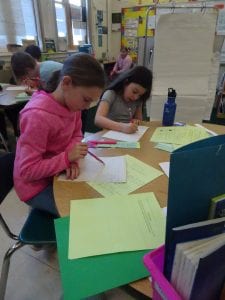 In addition to these friendship challenges, were continuing to find ways to meet behavioral and academic expectations. It is likely that we waste between 15 and 20 minutes everyday. The cumulative effect of that loss is noticeable now that we are in our last 40 days of school. We’ve decided that those who chat and goof around when independent learning practice is to be happening, or those who talk over lessons will miss recess to complete the work they did not do. We hope this never happens – but can serve as a reminder to stay focused, and to behave as expected.
In addition to these friendship challenges, were continuing to find ways to meet behavioral and academic expectations. It is likely that we waste between 15 and 20 minutes everyday. The cumulative effect of that loss is noticeable now that we are in our last 40 days of school. We’ve decided that those who chat and goof around when independent learning practice is to be happening, or those who talk over lessons will miss recess to complete the work they did not do. We hope this never happens – but can serve as a reminder to stay focused, and to behave as expected.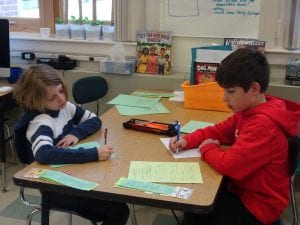 Social problems are tricky. Friends don’t always want to listen, and as I said at the beginning of the newsletter, our classmates do not own all of their behaviors and choices. It’s a learning process and one we’ll get through. Right now, however, there are some hurt feelings that are not lessening yet. L With attention and effort that will change.
Social problems are tricky. Friends don’t always want to listen, and as I said at the beginning of the newsletter, our classmates do not own all of their behaviors and choices. It’s a learning process and one we’ll get through. Right now, however, there are some hurt feelings that are not lessening yet. L With attention and effort that will change.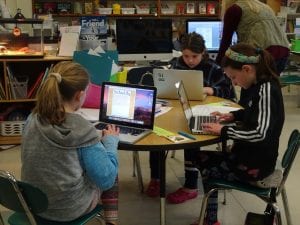 This week we chose the name for the event where we will share the seven Wonders of the sixteen countries we have chosen. We have decided to call it
This week we chose the name for the event where we will share the seven Wonders of the sixteen countries we have chosen. We have decided to call it 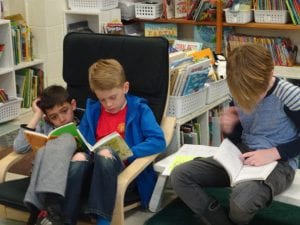 The deadline is fast approaching. If your son or daughter is expressing concern, get in touch with me, and we can schedule a time to come before school to work in it. They are welcome to bring it home, and some of the children have been doing that. I know they will do all they can and I think they’ll meet the deadline just fine. But I know how worry creeps in at bedtime, so let me know.
The deadline is fast approaching. If your son or daughter is expressing concern, get in touch with me, and we can schedule a time to come before school to work in it. They are welcome to bring it home, and some of the children have been doing that. I know they will do all they can and I think they’ll meet the deadline just fine. But I know how worry creeps in at bedtime, so let me know. Our
Our  This week in Open Circle we continued talking about ways to organize ourselves to be more successful and complete each step of our assignments. The class is making an effort to follow through with time management so everything is done – even the things that are not as much as others.
This week in Open Circle we continued talking about ways to organize ourselves to be more successful and complete each step of our assignments. The class is making an effort to follow through with time management so everything is done – even the things that are not as much as others.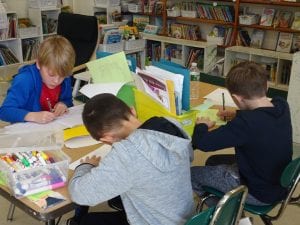 Over the past two weeks we’ve been sharing books about seeds and growing. We’ve looked at how informational books are organized and we’ve explored how authors of fiction weave facts into their stories. We collected a list of facts as a class, and from these (along with what we know about the seed growing in our classroom and the greenhouse) each student wrote a topic sentence, or lead, and their organized their thinking so they were prepared to write about three subtopics with supporting details. This was a challenge. Why plan? Why not just write?
Over the past two weeks we’ve been sharing books about seeds and growing. We’ve looked at how informational books are organized and we’ve explored how authors of fiction weave facts into their stories. We collected a list of facts as a class, and from these (along with what we know about the seed growing in our classroom and the greenhouse) each student wrote a topic sentence, or lead, and their organized their thinking so they were prepared to write about three subtopics with supporting details. This was a challenge. Why plan? Why not just write?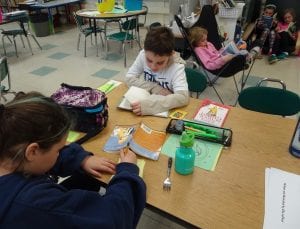 I think most of the children have come to see the benefit of planning. It keeps facts from being scattered here and there. It helps the writer share information in a way that will make sense to the reader.
I think most of the children have come to see the benefit of planning. It keeps facts from being scattered here and there. It helps the writer share information in a way that will make sense to the reader. We’ve continued our search for Wonders. We think that we’ll be ready to share our research and displays just before April vacation. This project will share our third through tenth time attempting to write organized paragraphs. Our goal is to share more elaborate writing. The class is starting to get excited about what they are learning about the world. They are surprised the by animals and beautiful natural places. In technology they were introduced to Google Earth. Many of them were able to find and explore the natural wonders in their countries. They had fun seeing the landscape as it is today.
We’ve continued our search for Wonders. We think that we’ll be ready to share our research and displays just before April vacation. This project will share our third through tenth time attempting to write organized paragraphs. Our goal is to share more elaborate writing. The class is starting to get excited about what they are learning about the world. They are surprised the by animals and beautiful natural places. In technology they were introduced to Google Earth. Many of them were able to find and explore the natural wonders in their countries. They had fun seeing the landscape as it is today.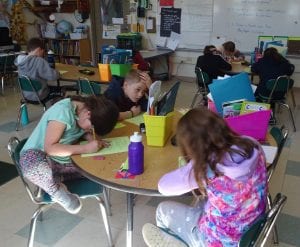 This week we read Sadako and the Thousand Paper Cranes. If you’ve read the story before, you can imagine there were many question and lots of conversation about radiation, leukemia, the atom bomb and Peace Park in Hiroshima. We have looked at some pictures, read some other information about World War II and tried to understand how knowing this sad story can help us make more empathetic choices in the future. I’m sure the children would be glad to tell you about the story and how Sadako is a national symbol for hope and peace in Japan. It would also help them to talk through their confusions and concerns.
This week we read Sadako and the Thousand Paper Cranes. If you’ve read the story before, you can imagine there were many question and lots of conversation about radiation, leukemia, the atom bomb and Peace Park in Hiroshima. We have looked at some pictures, read some other information about World War II and tried to understand how knowing this sad story can help us make more empathetic choices in the future. I’m sure the children would be glad to tell you about the story and how Sadako is a national symbol for hope and peace in Japan. It would also help them to talk through their confusions and concerns.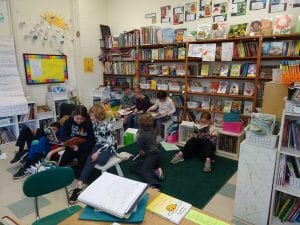 It seems as through more of the class understands how to use the standard algorithm with addition. This was a challenging step. I know it doesn’t seem that way, but the children have organized their thinking through expanded notation for a while. Though it takes many more steps they feel sure of it. The algorithm is new and seems backwards to them at first. When you look through this week’s work, you may notice a range of strategies. If you’re not seeing the standard algorithm, please know it is coming. We’ve been practicing as a class, so little by little understanding and certainty will come.
It seems as through more of the class understands how to use the standard algorithm with addition. This was a challenging step. I know it doesn’t seem that way, but the children have organized their thinking through expanded notation for a while. Though it takes many more steps they feel sure of it. The algorithm is new and seems backwards to them at first. When you look through this week’s work, you may notice a range of strategies. If you’re not seeing the standard algorithm, please know it is coming. We’ve been practicing as a class, so little by little understanding and certainty will come. We are exploring
We are exploring Hachiko from Japan. The final book is also realistic fiction, but told from the point of view of a fox. As we finish the clubs next week, we’ll be learning more about summaries and reviews. Perhaps we’ll be able to convince others to read the books based on our recommendations.
Hachiko from Japan. The final book is also realistic fiction, but told from the point of view of a fox. As we finish the clubs next week, we’ll be learning more about summaries and reviews. Perhaps we’ll be able to convince others to read the books based on our recommendations.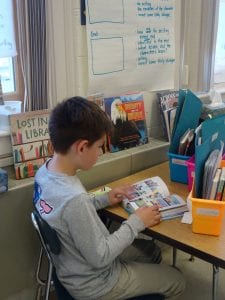 We’ll be
We’ll be  We’ve been enjoying some wonderful recess weather and games. It is a relief to be without heavy coats and all that gear. We’ve begun a new social problem-solving unit in Open Circle and we’ve begun planting, both in the greenhouse, and in our classroom. We’ve continued book clubs and writing responses to help us recall more details from our reading.
We’ve been enjoying some wonderful recess weather and games. It is a relief to be without heavy coats and all that gear. We’ve begun a new social problem-solving unit in Open Circle and we’ve begun planting, both in the greenhouse, and in our classroom. We’ve continued book clubs and writing responses to help us recall more details from our reading. We also began to learn about seeds. We soaked different types of beans so that we could learn about, see and label the five main parts of a seed. It was fun to see that the first leaves and roots are already in the seed before it is planted. All a seed needs is water and warmth – soon there will be a sprout.
We also began to learn about seeds. We soaked different types of beans so that we could learn about, see and label the five main parts of a seed. It was fun to see that the first leaves and roots are already in the seed before it is planted. All a seed needs is water and warmth – soon there will be a sprout.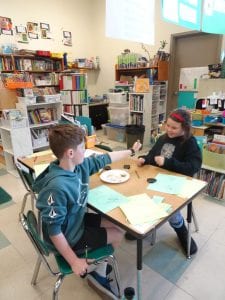 Last week we worked through a three step paragraphing process. First we collected facts about Mary Poppins. Next we chose what was most important on our list. From this we developed a t-chart with the topic sentence and three subtopics with their supporting details. From this chart we were able to create a three-paragraph description of Mary Poppins.
Last week we worked through a three step paragraphing process. First we collected facts about Mary Poppins. Next we chose what was most important on our list. From this we developed a t-chart with the topic sentence and three subtopics with their supporting details. From this chart we were able to create a three-paragraph description of Mary Poppins.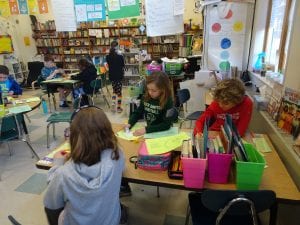 This is the same process the children will use to write paragraphs about their country wonders. We are hoping when you attend this museum, you’ll be able to see how our writing abilities have grown.
This is the same process the children will use to write paragraphs about their country wonders. We are hoping when you attend this museum, you’ll be able to see how our writing abilities have grown.
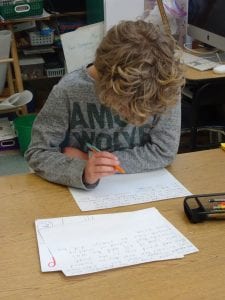 homes to find safer places. We’ve read Four Feet, Two Sandals, Gleam and Glowand Flowers for Sarajevo. We are realizing there are many things we can do to make the world happier and more peaceful. A smile is a good first step.
homes to find safer places. We’ve read Four Feet, Two Sandals, Gleam and Glowand Flowers for Sarajevo. We are realizing there are many things we can do to make the world happier and more peaceful. A smile is a good first step. Spring is here! Yay! The snow has melted off the field and recess is full of running sliding and mud. (Sorry, but they did have fun J). The sun feels wonderful and we are looking forward to the final third of this third grade year. This week we’ve spent time talking about the difference between having the ability to do something and actually doing it. We talked about the importance of thoughtfully approaching each task and reflecting on how our choices can help us learn … or not. Keeping our reading logs will help us uncover patterns that can help us grow as readers. Crafting sentences are thoughtfully can help us communicate more effectively with our readers.
Spring is here! Yay! The snow has melted off the field and recess is full of running sliding and mud. (Sorry, but they did have fun J). The sun feels wonderful and we are looking forward to the final third of this third grade year. This week we’ve spent time talking about the difference between having the ability to do something and actually doing it. We talked about the importance of thoughtfully approaching each task and reflecting on how our choices can help us learn … or not. Keeping our reading logs will help us uncover patterns that can help us grow as readers. Crafting sentences are thoughtfully can help us communicate more effectively with our readers.
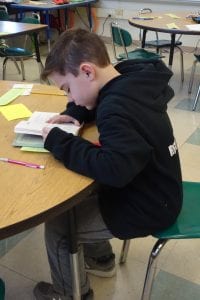 This week we began a new round of book clubs. The students are working in groups of two, three and four to read, write about and discuss what’s happening in their books. The groups are reading: Please Write In This Book, The Case of the School Ghost, The Mystery of the Stolen Statue, Hachiko Waits and The Gadget War. Each group is organizing their own reading times, amount and are selecting the type of response they would like to do with each reading. I’m pleased to share that most of the children are taking the responsibility to meet the deadlines and to be prepared to meet and share. They are using the following response strategies: Sketch to Stretch, Essence Summary, or A Line a Page. Everyone in the class seems to be having fun. They enjoy sharing their ideas and realize that they can do that more effectively when they take time to reflect on their reading.
This week we began a new round of book clubs. The students are working in groups of two, three and four to read, write about and discuss what’s happening in their books. The groups are reading: Please Write In This Book, The Case of the School Ghost, The Mystery of the Stolen Statue, Hachiko Waits and The Gadget War. Each group is organizing their own reading times, amount and are selecting the type of response they would like to do with each reading. I’m pleased to share that most of the children are taking the responsibility to meet the deadlines and to be prepared to meet and share. They are using the following response strategies: Sketch to Stretch, Essence Summary, or A Line a Page. Everyone in the class seems to be having fun. They enjoy sharing their ideas and realize that they can do that more effectively when they take time to reflect on their reading. We are two thirds of the way through reading Mary Poppins. She is quite different in the book, than she was in the play or the movie. To learn about paragraphing to we brainstormed a list of statements we could make about Mary Poppins based on what we’d read so far. Once we had collected ten statements, we decided that the most important thing about her is that she is magical.
We are two thirds of the way through reading Mary Poppins. She is quite different in the book, than she was in the play or the movie. To learn about paragraphing to we brainstormed a list of statements we could make about Mary Poppins based on what we’d read so far. Once we had collected ten statements, we decided that the most important thing about her is that she is magical.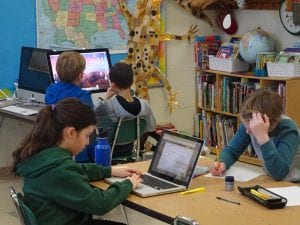 she does surprising and unpredictable things. We added supporting details from the text as evidence and in no time we had a three -paragraph piece about Mary Poppins.
she does surprising and unpredictable things. We added supporting details from the text as evidence and in no time we had a three -paragraph piece about Mary Poppins.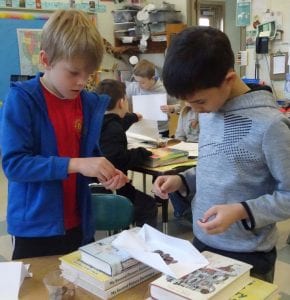 A force is a push or a pull. That idea was easy to understand when we watched a tug-of-war. We understood the different forces that made our Hopper Popper jump HIGH last week. We discovered we could change the strength of the force by adding more rubber bands or by using thicker rubber bands or by changing the size and weight of the popper.
A force is a push or a pull. That idea was easy to understand when we watched a tug-of-war. We understood the different forces that made our Hopper Popper jump HIGH last week. We discovered we could change the strength of the force by adding more rubber bands or by using thicker rubber bands or by changing the size and weight of the popper. This week we expanded our understanding of force by looking at bridges. How do the lines of force help engineers design bridges? How do they balance pushes and pulls so the bridges we build can hold weight? How do they design bridges so they are safe to use? We learned some about pedestal, arch and truss bridges. Once we knew about bridges, we took on an engineering challenge to design a bridge using just two pieces of regular copy paper. The extra competition was to see which bridge could hold the most pennies (or coins when we had no more pennies to use).
This week we expanded our understanding of force by looking at bridges. How do the lines of force help engineers design bridges? How do they balance pushes and pulls so the bridges we build can hold weight? How do they design bridges so they are safe to use? We learned some about pedestal, arch and truss bridges. Once we knew about bridges, we took on an engineering challenge to design a bridge using just two pieces of regular copy paper. The extra competition was to see which bridge could hold the most pennies (or coins when we had no more pennies to use).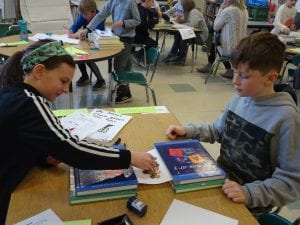 The fun part of this challenge was that we hoped we’d fail, because each failure helped us to discover a solution. We discovered that sheets of paper could become very strong when we change their shape by crumpling, folding or coiling. We had fun building and discovering how force impacts a structure. Whether a bridge held 80 pennies of 280 pennies each team learned how to change a design at the point of failure. We discovered that paper is strong with the right design. Ask your child what he or she did to strengthen the paper so the bridge would stand.
The fun part of this challenge was that we hoped we’d fail, because each failure helped us to discover a solution. We discovered that sheets of paper could become very strong when we change their shape by crumpling, folding or coiling. We had fun building and discovering how force impacts a structure. Whether a bridge held 80 pennies of 280 pennies each team learned how to change a design at the point of failure. We discovered that paper is strong with the right design. Ask your child what he or she did to strengthen the paper so the bridge would stand.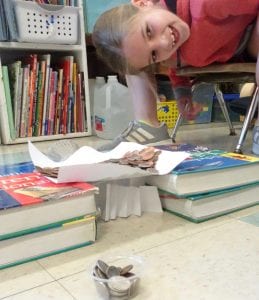
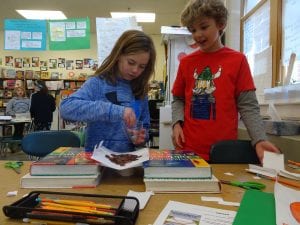
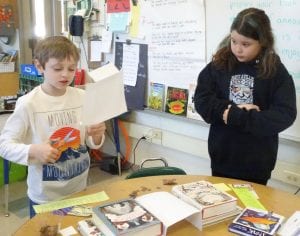
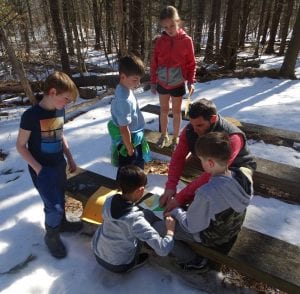
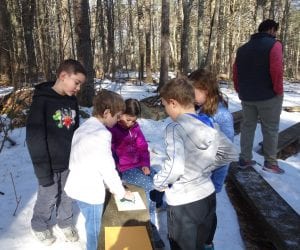
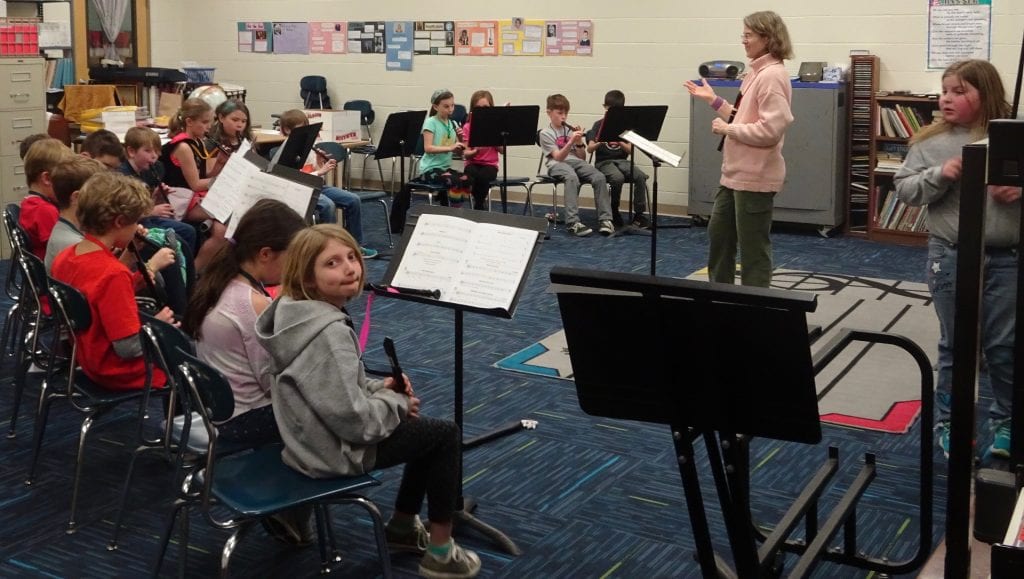
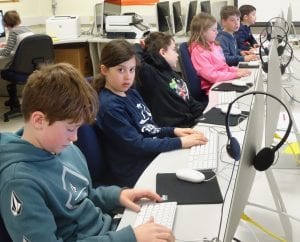 It seems wild that we have already reach the mid-point of March, and that we are two-thirds of the way through our school year. The days and weeks are flying by. I guess they always do, but I wish things could slow down a little so we can fit in more book discussions and research projects and art and building and, well, just have more time together. I know we’ll accomplish all that we can, but I’m just wishing to fit everything in so it feels exciting and well done.
It seems wild that we have already reach the mid-point of March, and that we are two-thirds of the way through our school year. The days and weeks are flying by. I guess they always do, but I wish things could slow down a little so we can fit in more book discussions and research projects and art and building and, well, just have more time together. I know we’ll accomplish all that we can, but I’m just wishing to fit everything in so it feels exciting and well done.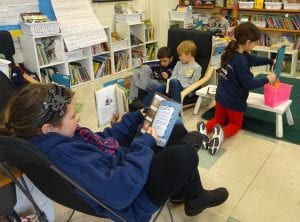 We’ve been reading picture books about friendships, feelings and kindness. We’ve been reading about different places around the world and the ways that people are the same and different at the same time. We’re halfway through Mary Poppinsand are excited to compare the book and the play.
We’ve been reading picture books about friendships, feelings and kindness. We’ve been reading about different places around the world and the ways that people are the same and different at the same time. We’re halfway through Mary Poppinsand are excited to compare the book and the play.
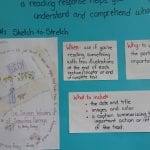
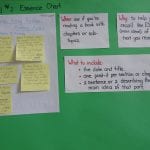 We are exploring different ways to respond to reading. We’ve learned three response types so far: Sketch to Stretch, Essence Charts and A Reflection Each Page. We practiced the final strategy together as a class while we were reading a chapter of Mary Poppins. We are also beginning a new round of book clubs. One group began this week and they’ve been able to see the benefit of keeping track of reading by writing. It really helps you think about what happening and to remember it.
We are exploring different ways to respond to reading. We’ve learned three response types so far: Sketch to Stretch, Essence Charts and A Reflection Each Page. We practiced the final strategy together as a class while we were reading a chapter of Mary Poppins. We are also beginning a new round of book clubs. One group began this week and they’ve been able to see the benefit of keeping track of reading by writing. It really helps you think about what happening and to remember it.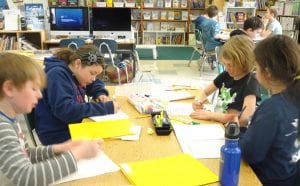 The fourth month of the 3E book contest and awards is coming up. The children are truly excited about creating innovative books and interesting stories. Often the children work together building the stories a page at a time. Some are really thinking of how they can include each of the elaboration strategies within each story. The ideas always start off great. Many of them leave us wishing for more when they end. The words, “to be continued,” often leave the class groaning.
The fourth month of the 3E book contest and awards is coming up. The children are truly excited about creating innovative books and interesting stories. Often the children work together building the stories a page at a time. Some are really thinking of how they can include each of the elaboration strategies within each story. The ideas always start off great. Many of them leave us wishing for more when they end. The words, “to be continued,” often leave the class groaning.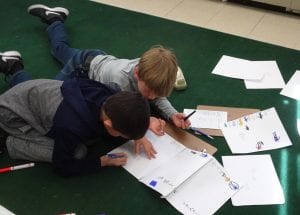 We have continued to work on sentence construction. We’ve practiced constructing simple, compound and complex sentences when looking at photographs of pictures of children from the countries we’ve begun researching. We’ve continued to focus on narrative
We have continued to work on sentence construction. We’ve practiced constructing simple, compound and complex sentences when looking at photographs of pictures of children from the countries we’ve begun researching. We’ve continued to focus on narrative 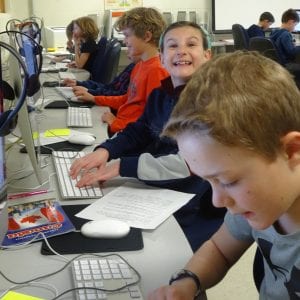 writing and done a teeny bit of more revision with our family stories.
writing and done a teeny bit of more revision with our family stories. We’ve been working with large amounts and place value. We’ve been reading amounts through the billions and identifying the value of digits in certain places. We’ve learned about the periods in numbers and how each period has a ones, tens and hundreds place. We’ve also been dealing with equivalent amounts such as 4 hundreds equaling 40 tens or 400 ones. We’ve also solved a variety of place value riddles. This work with place value is to help all of the children feel comfortable using the standard algorithm for addition and subtraction. Some of them are already there, while others feel nervous about making that step.
We’ve been working with large amounts and place value. We’ve been reading amounts through the billions and identifying the value of digits in certain places. We’ve learned about the periods in numbers and how each period has a ones, tens and hundreds place. We’ve also been dealing with equivalent amounts such as 4 hundreds equaling 40 tens or 400 ones. We’ve also solved a variety of place value riddles. This work with place value is to help all of the children feel comfortable using the standard algorithm for addition and subtraction. Some of them are already there, while others feel nervous about making that step.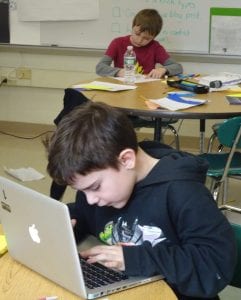
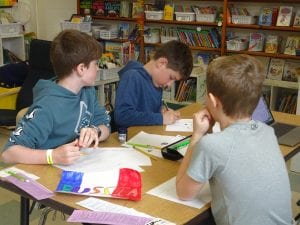 We’ve been working with Mrs. Herlihy in technology to create a weather forecast. We gathered the data in class, created the slides in technology and are now ready to write the script for the forecast. In two weeks time we hope to film our forecasts. It’s been quite a long process – surprising how our delays interrupted our scheduled technology times. Even though the process this year has been more draw out than we’d hoped, I think the children are learning a lot about weather, climates, mapping and are developing many technology skills they will use from now on in making presentations.
We’ve been working with Mrs. Herlihy in technology to create a weather forecast. We gathered the data in class, created the slides in technology and are now ready to write the script for the forecast. In two weeks time we hope to film our forecasts. It’s been quite a long process – surprising how our delays interrupted our scheduled technology times. Even though the process this year has been more draw out than we’d hoped, I think the children are learning a lot about weather, climates, mapping and are developing many technology skills they will use from now on in making presentations. We are having fun
We are having fun  I hope you had a restful and enjoyable vacation. Sorry to those who were touched by the stomach bug or were hit hard by colds. That’s not a fun way to spend any time, much less a vacation. I hope everyone is healing well and found some time for vacation fun. It seems though we, in 3E, are back in full swing – everyone has been here each day this week, so we’ll keep our fingers crossed.
I hope you had a restful and enjoyable vacation. Sorry to those who were touched by the stomach bug or were hit hard by colds. That’s not a fun way to spend any time, much less a vacation. I hope everyone is healing well and found some time for vacation fun. It seems though we, in 3E, are back in full swing – everyone has been here each day this week, so we’ll keep our fingers crossed.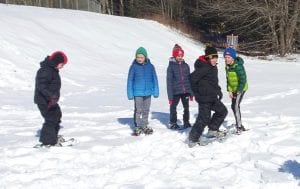 We’ve had a week filled with exciting opportunities. No school Monday, led to double lessons about reading response notebooks on Tuesday. The snow on Monday allowed us to spend our challenge time snowshoeing. It was a gorgeous winter day – perfect for a short snowshoe walk. We learned that snowshoeing is surprisingly hard work in new snow. We were glad for the snowshoes and for time outdoors in the woods. Wednesday was also the first day with our recorders – a much-anticipated day. Thursday we had the opportunity to see Mary Poppins at the Palace Theater. It was a musical and it was wonderful. We are looking forward to comparing the book, the play and the movie. Quite a week!
We’ve had a week filled with exciting opportunities. No school Monday, led to double lessons about reading response notebooks on Tuesday. The snow on Monday allowed us to spend our challenge time snowshoeing. It was a gorgeous winter day – perfect for a short snowshoe walk. We learned that snowshoeing is surprisingly hard work in new snow. We were glad for the snowshoes and for time outdoors in the woods. Wednesday was also the first day with our recorders – a much-anticipated day. Thursday we had the opportunity to see Mary Poppins at the Palace Theater. It was a musical and it was wonderful. We are looking forward to comparing the book, the play and the movie. Quite a week! We’ve struggled to find time to work on our family stories, but little by little we are conferencing and the children are adding information an answering questions to expand their stories. We also re-examined the three different types of sentences: simple, complex and compound. We’ve continued to learn about description and phrases and clauses. The children have been asked to think about what they are creating and to make choices about the sentences they create so the include all of the different types.
We’ve struggled to find time to work on our family stories, but little by little we are conferencing and the children are adding information an answering questions to expand their stories. We also re-examined the three different types of sentences: simple, complex and compound. We’ve continued to learn about description and phrases and clauses. The children have been asked to think about what they are creating and to make choices about the sentences they create so the include all of the different types.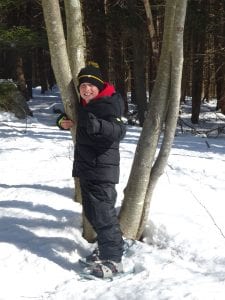 You can see some of this work on the latest blog posts. Most of the students were able to write and publish a personal narrative telling of a small vacation moment. These posts are showing what they know about narrative writing and what they can independently create in a forty-minute timeframe.
You can see some of this work on the latest blog posts. Most of the students were able to write and publish a personal narrative telling of a small vacation moment. These posts are showing what they know about narrative writing and what they can independently create in a forty-minute timeframe.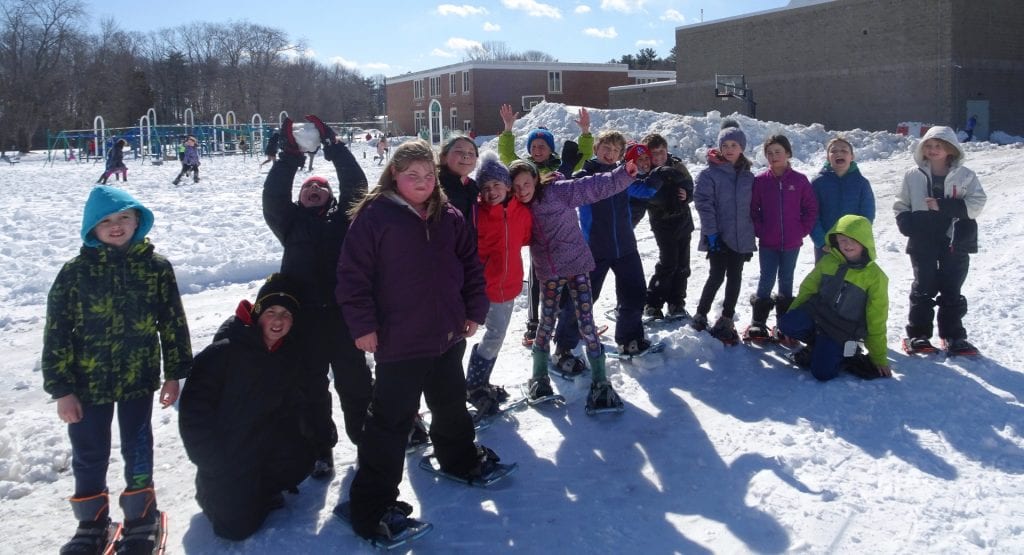
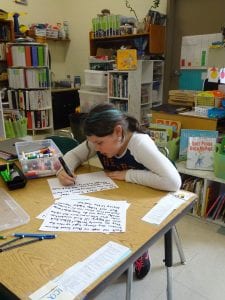 We began reading
We began reading  We’ve had quite a bit of
We’ve had quite a bit of 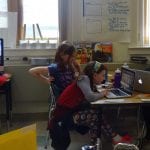 minutes for a some children to come into the classroom after a UA class, recess or snack because they are getting drinks from water bottles or sharing and showing and playing with their treasures.
minutes for a some children to come into the classroom after a UA class, recess or snack because they are getting drinks from water bottles or sharing and showing and playing with their treasures. 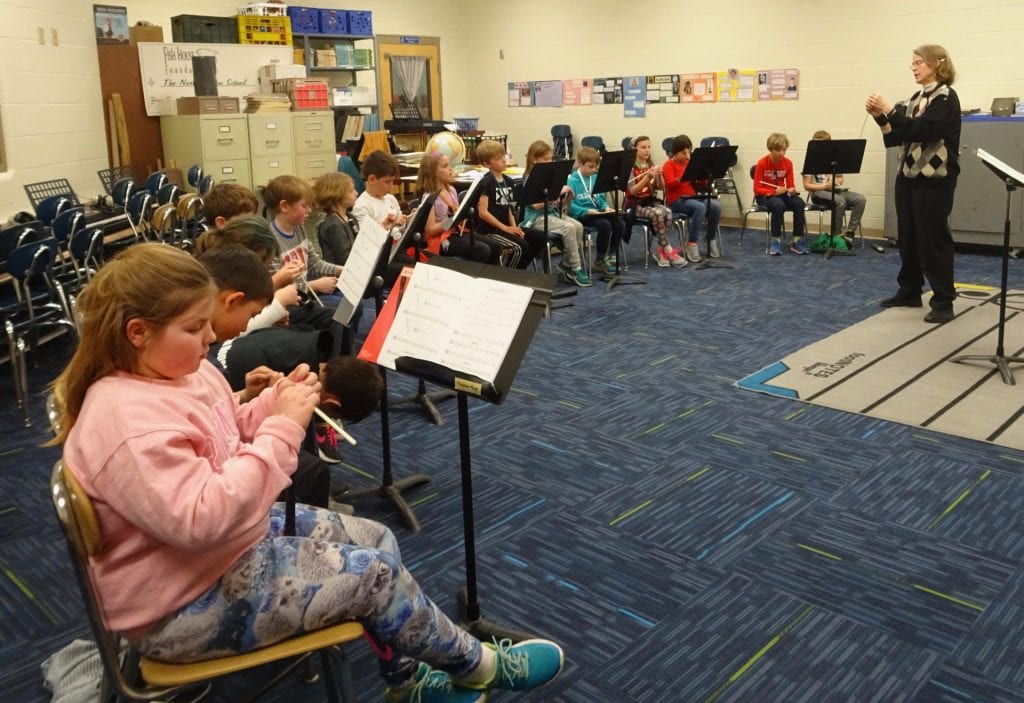
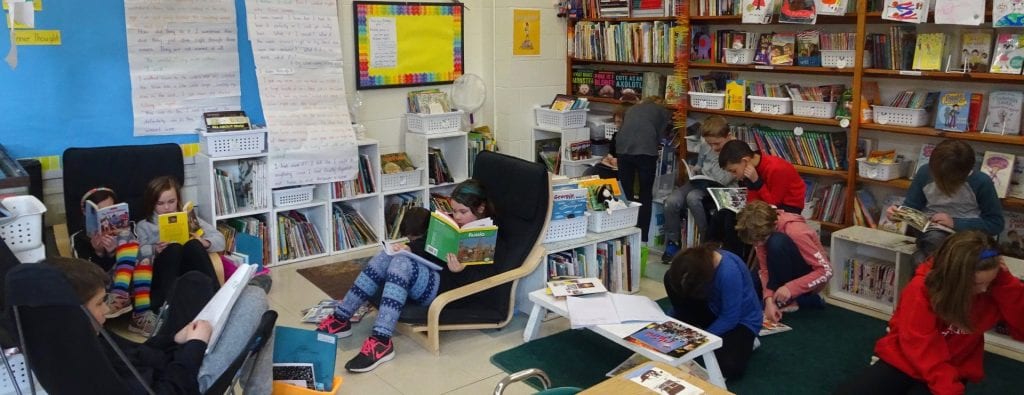 We’ve continued to explore the world, kindness and peace through the poems and books we’ve been reading. The children have begun researching a country and are beginning to discover many Wonders around the world.
We’ve continued to explore the world, kindness and peace through the poems and books we’ve been reading. The children have begun researching a country and are beginning to discover many Wonders around the world. This month we’ve been keeping track of all the books we’ve read. We’ve recorded all the books we’ve read together as a class. The students have each recorded all of their own books. We’ve been trying to keep track of everything. As a class we started and completed 28 books this month. We mostly read realistic fiction, biographies and informational books. Our chapter read-aloud was historical fiction. Because of this record we’re going to challenge ourselves next month to read fantasy and traditional folktales and fables. The children will be looking at their records to see how they can push themselves to read other genre as well.
This month we’ve been keeping track of all the books we’ve read. We’ve recorded all the books we’ve read together as a class. The students have each recorded all of their own books. We’ve been trying to keep track of everything. As a class we started and completed 28 books this month. We mostly read realistic fiction, biographies and informational books. Our chapter read-aloud was historical fiction. Because of this record we’re going to challenge ourselves next month to read fantasy and traditional folktales and fables. The children will be looking at their records to see how they can push themselves to read other genre as well.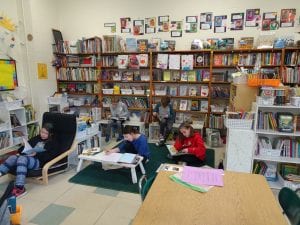
 All of the students have completed the second drafts of their family story. They have focused on using description, dialogue, action, and inner thought to create the most interesting stories that they can. We’ll go through one more step of conferencing, feedback, revision and conferencing again for final revision to create a final piece of writing that we’ll be ready to illustrate and share by mid-March.
All of the students have completed the second drafts of their family story. They have focused on using description, dialogue, action, and inner thought to create the most interesting stories that they can. We’ll go through one more step of conferencing, feedback, revision and conferencing again for final revision to create a final piece of writing that we’ll be ready to illustrate and share by mid-March. We’ve also noticed that lots of books submitted to be share each month are begun – but end with “to be continued” rather than being fully written. We’ve decided to work on this. Knowing how to end stories is as important as developing the ideas at the beginning.
We’ve also noticed that lots of books submitted to be share each month are begun – but end with “to be continued” rather than being fully written. We’ve decided to work on this. Knowing how to end stories is as important as developing the ideas at the beginning. We finished reading The Seven Wonders of Sassafras Springs. The last Wonder Eben found was a 3-D map of his town. We are going to create our own map of Sassafras Springs to show how we imagine the town and the places where Eben walked. We’ll add all that we know maps include as we make it.
We finished reading The Seven Wonders of Sassafras Springs. The last Wonder Eben found was a 3-D map of his town. We are going to create our own map of Sassafras Springs to show how we imagine the town and the places where Eben walked. We’ll add all that we know maps include as we make it.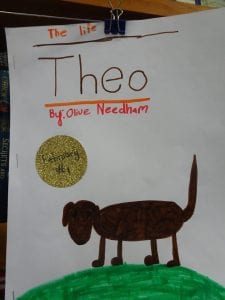
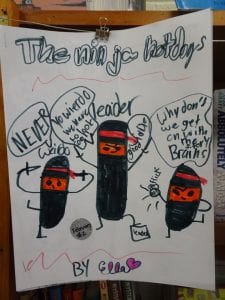
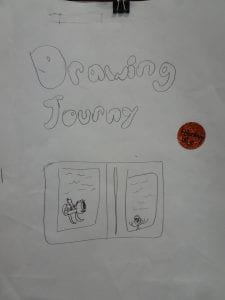
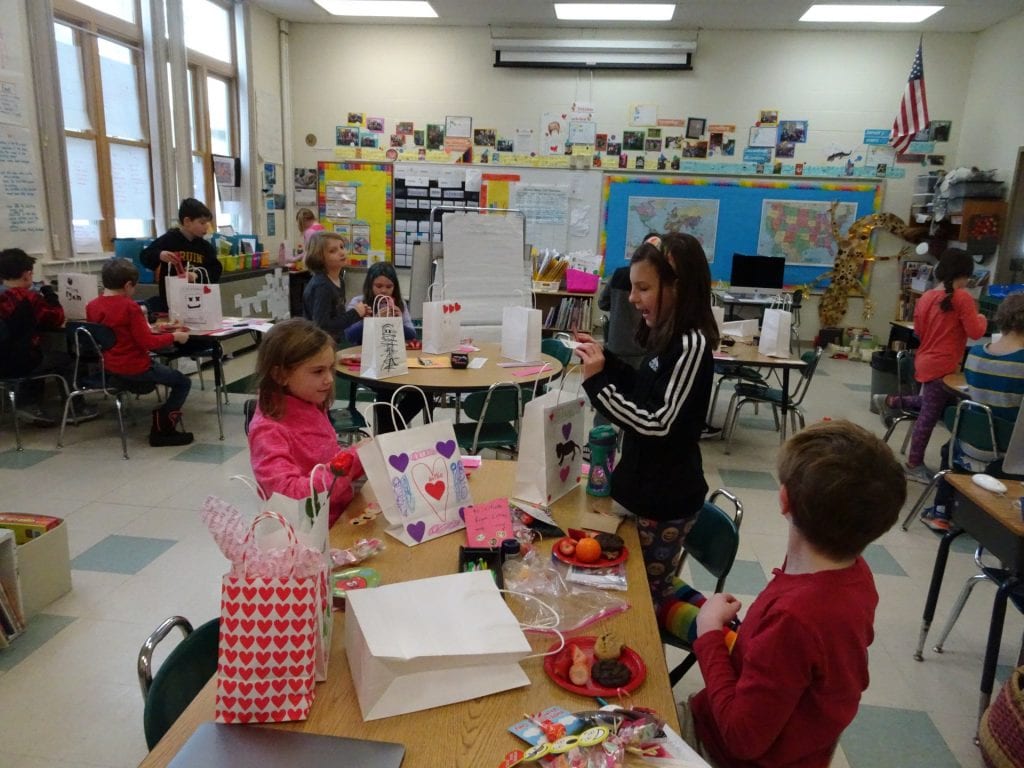 Thank you for helping us have a wonderful Valentines Day. The children were thrilled with their treats and trinkets. We had a fun morning sharing and “squeaking” together.
Thank you for helping us have a wonderful Valentines Day. The children were thrilled with their treats and trinkets. We had a fun morning sharing and “squeaking” together. We’ve rearranged our daily schedule and routines in ways that encourage the children to be more reflective and thoughtful. I hope to help them get the most out of their learning. I’m asking them to put forth a bit more effort so their products show more of what they know. I don’t want them to over-analyze. No one will finish anything. I have been asking them to revise their writing, select different genre when reading or to consider solving a different type of problem. I’m pleased with how many in the class are focusing their attention and effort. Let them know what you see in the work that comes home on Friday, or in the content of their blog posts.
We’ve rearranged our daily schedule and routines in ways that encourage the children to be more reflective and thoughtful. I hope to help them get the most out of their learning. I’m asking them to put forth a bit more effort so their products show more of what they know. I don’t want them to over-analyze. No one will finish anything. I have been asking them to revise their writing, select different genre when reading or to consider solving a different type of problem. I’m pleased with how many in the class are focusing their attention and effort. Let them know what you see in the work that comes home on Friday, or in the content of their blog posts.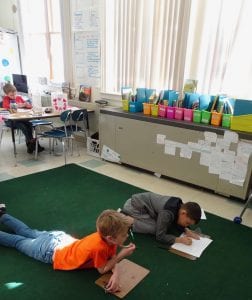
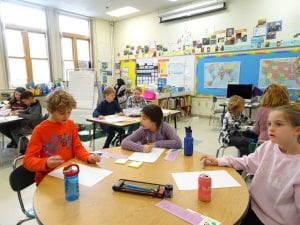 Most of the children know the difference between the terms: area and perimeter. When we talked about problems that included fencing in an area to keep animals safe the concept began to take shape. Each morning we are charting the growing patterns in our calendar and that is helping too. See if your child can explain these to concepts and how each of them is helping us practice both, our basic addition and multiplication facts.
Most of the children know the difference between the terms: area and perimeter. When we talked about problems that included fencing in an area to keep animals safe the concept began to take shape. Each morning we are charting the growing patterns in our calendar and that is helping too. See if your child can explain these to concepts and how each of them is helping us practice both, our basic addition and multiplication facts.

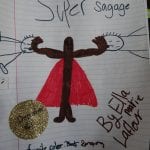
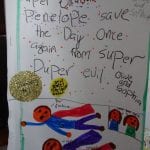 We’ve been working on our
We’ve been working on our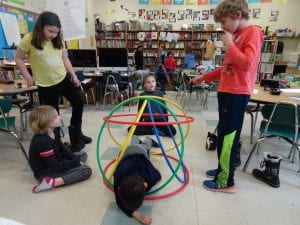
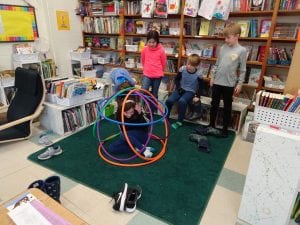

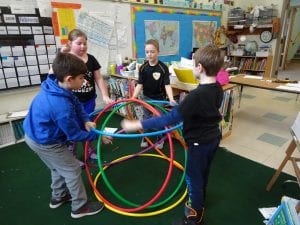
 Thank you for making our Holiday Palooza such a success. Thank you for touring the displays and talking to the children about all they’d discovered about holidays, researching and informational writing. Thank you for taking the time to play their games and to learn from them. Many of the kids were able to design a Palooza blog post this week – it seems like they had a great time sharing with all of you.
Thank you for making our Holiday Palooza such a success. Thank you for touring the displays and talking to the children about all they’d discovered about holidays, researching and informational writing. Thank you for taking the time to play their games and to learn from them. Many of the kids were able to design a Palooza blog post this week – it seems like they had a great time sharing with all of you. We’ve begun our 8thchapter read aloud, The Seven Wonders of Sassafras Springs by Betty Birney. The book is set in rural Sassafras Springs, Missouri in 1923. Eben, the main character, wishes he could travel the world and see things like The Seven Ancient Wonders of the world. He complains that his life is too dull and too boring to bear so he father offers him a challenge. He’s got seven days to see if he can find seven wonders in his sleepy town. If he does, he’ll get a train ticket to travel to the Rocky Mountains in Colorado to visit cousins there. With this exciting prospect and a pad of paper to keep track of his collection, Eben sets off to see what he can find.
We’ve begun our 8thchapter read aloud, The Seven Wonders of Sassafras Springs by Betty Birney. The book is set in rural Sassafras Springs, Missouri in 1923. Eben, the main character, wishes he could travel the world and see things like The Seven Ancient Wonders of the world. He complains that his life is too dull and too boring to bear so he father offers him a challenge. He’s got seven days to see if he can find seven wonders in his sleepy town. If he does, he’ll get a train ticket to travel to the Rocky Mountains in Colorado to visit cousins there. With this exciting prospect and a pad of paper to keep track of his collection, Eben sets off to see what he can find.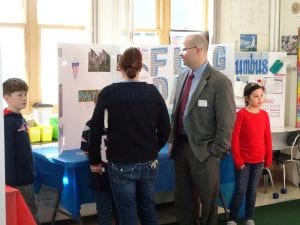 So far in our reading, Eben’s been able to find two Wonders in two days and things are looking promising. We’ll use this book to guide our next research project. We’ll be searching for Wonders around the world in different countries we explore.
So far in our reading, Eben’s been able to find two Wonders in two days and things are looking promising. We’ll use this book to guide our next research project. We’ll be searching for Wonders around the world in different countries we explore.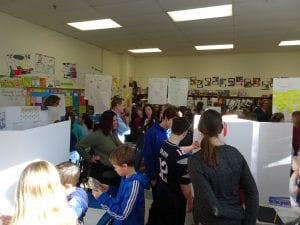 We’ve begun to explore books that share pictures from many different places around the world. I hope to inspire the children to begin thinking about places in the world they’d like to know more about.
We’ve begun to explore books that share pictures from many different places around the world. I hope to inspire the children to begin thinking about places in the world they’d like to know more about.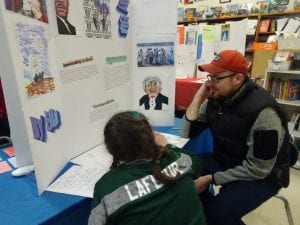 we are careful and develop respect for differences without calling them weird. We’ll also need to take care to not make assumptions based on only one piece of information.
we are careful and develop respect for differences without calling them weird. We’ll also need to take care to not make assumptions based on only one piece of information.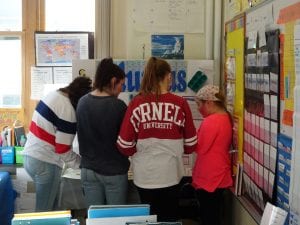 school year. We are learning the perimeter is the total distance around the outside of a 2D shape. Add up the length of all sides and you’ll know the perimeter. We are also learning that you can calculate the area of shapes made up of rectangles by breaking them into individual rectangles.
school year. We are learning the perimeter is the total distance around the outside of a 2D shape. Add up the length of all sides and you’ll know the perimeter. We are also learning that you can calculate the area of shapes made up of rectangles by breaking them into individual rectangles.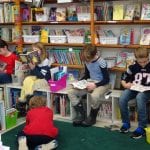 Thank you everyone for your generous support of the
Thank you everyone for your generous support of the  We are part of a Kindness read-aloud project. We began by sharing I Am Human and writing about what our
We are part of a Kindness read-aloud project. We began by sharing I Am Human and writing about what our